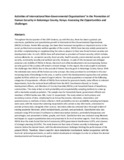| dc.description.abstract | Throughout the last quarter of the 20th Century, up until this day, there has been a gradual, yet
enormous, qualitative and quantitative growth in International Non-Governmental
Organizations (INGOs) in Kenya. Amidst this upsurge, has been their increased recognition
as important actors in the social, political and economic welfare agendas of the country.
INGOs have become widely perceived to be either complementing or supplementing the state
as players in their new-found human security and development roles. As such, INGOs have
self-advertised as providers of human security, which includes various elements viz.,
economic security, food security, health security, environmental security, personal security,
community security and political security. However, in spite of this increased and enlarged
presence and visibility of INGOs in Kenya, the much sort-after development and
accompanying human security goals of the country still remain a distant mirage. In this
regard, the study sought to evaluate the challenges that INGOs face in the pursuit of Human
Security goals in Kakamega County, Kenya. With the relatively new status of the human
security concept, the study promised to contribute to the ever increasing body of knowledge
in this area, as well as enrich the developmental approaches and policies applied in Africa
which are in need of urgent reform. The study population comprised of the following
categories of respondents: officials of INGOs from national to grassroots levels; state officers
in relevant departments, from the national level (officials from the NGO Coordination
Board), to County development officers, and Members of County Assembly (MCAs); and
household heads of beneficiary communities. The study relied on both probability and
nonprobability sampling methods to come up with a desirable sample population. The sample
sizes for household heads, government officials and members of INGO bodies was 384, 3
and 15 respectively. The study relied on both primary and secondary sources of data,
employing Focus Group Discussions, interviews, observation, and questionnaires as methods
of data collection. Both probability and non-probability sampling techniques were used, with
the researcher selecting respondents who served as key informants, envisioned to provide
primary data, alongside other sources. Secondary data was attained via a thorough review of
existing academic literature, which included books, journals, and periodicals. Quantitative
data was analyzed using SPSS version 23 software to obtain descriptive statistics, particularly
frequencies and percentages, and presented in tables, graphs, and charts. Qualitative data was
analyzed using thematic techniques to support quantitative data and presented in form of
narrative reports. From this evidence, INGOs face the study found that lack of autonomy
(20%) government interference 6.67%, and absence of strategic planning (26.67%). The
study found out that state of human security in Kakamega still remains below the desired
levels, with the aforementioned challenges limiting the performance of the present INGOs.
Therefore, there is need for more stakeholder involvement, better cooperation with the local
and national governments, as well as better development strategies in order to achieve the
desired developmental and human security goals | en_US |
| dc.subject | Activitie,International, Non-Governmental, Organizations’, Promotion , Human, Security, Assessing ,Opportunities , Challenges | en_US |

